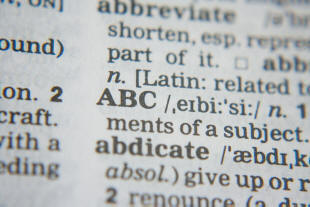Terminology in ELT

All professions have their own special terms and concepts and English
Language Teaching is no exception.
Please don't be tempted to lump the following under 'jargon' (which
usually means inappropriate use of technical language or a use intended
to obscure meaning). We need some technical language to help us
handle concepts peculiar to our profession.
What follows is not intended to be exhaustive but if you are familiar with most of the following, then you will not be distracted by unfamiliar terminology on an initial training course, at least.
 |
Other resources |
There are plenty of web-based and print-published resources for this
area which invariably list terms in alphabetic order. Two good
books are:
Scott Thornbury (2006), An A-Z of ELT, Macmillan
Jack C. Richards and Richard W. Schmidt
(2010),
Longman Dictionary of Language Teaching and Applied Linguistics,
4th edition, Longman
Web-based resources in this area are available by simply entering 'ELT glossary' into a reliable search engine, of course. Not all of these are entirely accurate; some are grossly inaccurate, so handle with care.
| There are other resources on this site that you may want to consult (all links except the tests open in a new tab). | |
| glossaries on this site | here you will find a list of all the glossaries on this site with some explanation of what they contain. |
| glossary of grammatical terms | this is an exemplified glossary designed for people doing (or who have just done) a CELTA course |
| glossary of methodology | this glossary defines but also explains the terms |
| phonology terminology | this is a short glossary explaining some essential terms in the area of pronunciation |
| the A-Z Index | this is a long list of all the concepts which occur in training guides on this site at any level of explanation |
| syllabus types | because this is a complex area with its own terminology, it gets a separate guide |
| search the site | use this if you can't find what you are looking for anywhere else |
| Tests | |
| a short test | a short test of your knowledge in a 20-item multiple-choice quiz format |
| 100-item test | a much more difficult and searching quiz in the Delta preparation section |
 |
On this page |
The following attempts to be slightly more helpful than many
lists by categorising the entries so that you can use it as a kind of
thesaurus if you are looking for a term to describe something in a
certain area.
The following is available as a PDF document without the helpful
links to guides on this site. Get it by
clicking here.
Links below will take you to guides on the topic.
From this page, all links except those
to tests open in a new tab.
Press Ctrl + F to search this page or use this menu to find the section you want:
 |
Acronyms and abbreviations |
- EAP
- English for Academic purposes intended for learners who want to go on to (usually) higher education in an English-medium institution. A section in the in-service training area on this site is devoted to English for Academic Purposes.
- EFL
- stands for English as a Foreign Language and refers to people learning the language to use it for social, travel, business or study purposes.
- ELT
- is a useful catch-all which stands for English Language Teaching. Conventionally, it refers to teaching the language to non-native speakers.
- ESL/ESOL
- stand for English as a Second Language / English to / for Speakers of Other Languages and usually refer to people learning English who already live in an English-speaking community but do not have English as a first language.
- ESP
- stands for English for Specific Purposes and these are usually things like Business, technical areas (English for Metallurgists etc.) and other specific areas. A sub-category is EOP which stands for English for Occupational Purposes. A section in the in-service training area on this site is devoted to English for Business.
 |
Learning and the learner |
- Acquisition vs. Learning
- Acquisition is the 'picking up' of a language through exposure
to it and is contrasted with learning which
involves deliberate study and practice. The distinction is
often credited to
Krashen.
For more, see the guide to Krashen and the Natural Approach. - Bilingual
- noun: a person able to speak a second language as well as if it was his
or her first language.
adjective: describing such a person.
There are also, of course, trilingual and multi-lingual people. In fact, multi-lingual people outnumber mono-lingual people worldwide. - Competence
- has two meanings:
1. it refers to a learner's ability to use the language, e.g., communicative competence (the ability to get and receive messages), linguistic competence (the ability to form accurate language), discourse competence (the ability to handle interaction and text structures) etc.
2. it refers to the ideal grammar which underlies all speakers' ability to use language. In this meaning, it is contrasted with performance.
For more, see the guide to Communicative Language Teaching (CLT). - Errors vs. Mistakes
- Error is usually used to refer to a systematic deviation from
the rules of language and is seen as part of the learning process.
Errors are contrasted with mistakes which are
usually the result of tiredness, distraction or cognitive overload
and are not systematic.
For more, see the guide to error. - First language
- usually written as L1 or L1 referring to the (or one of the) language(s) in which a speaker is completely fluent or learnt first. L2 is used to refer to the speaker's second language and LT (target language) to the language which is being taught/learnt.
- Fossilisation
- occurs when a learner's language ability ceases to improve.
It can also refer to an error that the learner is unable or
unwilling to eradicate. This is
often the result of a fall in
motivation caused by the realisation
that the learner's goals have been achieved.
For more, see the guide to motivation. - Generalisation
- refers to the learner drawing parallels and making assumption from the evidence available. For example, if you have learned that the past tense is often formed by adding -d or -ed to a verb stem you can generalise from this fact by guessing that the past tense of a verb you have not previously encountered will be formed in the same way. In the case of, e.g., dishearten you would be correct in guessing at disheartened but a false generalisation (or over-generalisation) will lead you to *misunderstanded.
- Interference vs. Facilitation
- refer to the negative or positive influences a learner's first
language will have on his/her ability to learn another.
For more, see the the guide to facilitation and interference. - Interlanguage
- refers to a learner's current command of the target language.
The theory is that a learner moves along a cline from no knowledge
of the language to full mastery and at any point on this cline we
can describe his/her
interlanguage as the current competence.
For more, see the section in the guide to error. - Learning
- see Acquisition vs. Learning above.
- Mistake
- see Errors vs. Mistakes above.
- Noticing
- There are two kinds of noticing:
1. noticing the language one sees and hears.
2. noticing the difference between what one produces and what one sees or hears (noticing the gap).
There is a guide to noticing on this site. - Over-generalisation
- also called ignorance of rule restriction. See Generalisation above.
- Performance
- the actually demonstrated ability to use a language as opposed to the speaker's knowledge about language. The latter is often referred to as competence.
- Transfer
- has two meanings:
1. the influence of other acquired or learned language(s) on the learning of the target language (positive or negative transfer).
2. the use of skills deployed in one language in the use of another language.
 |
Communication |
- Appropriacy and Appropriateness
- refers to the acceptability in the speech community of certain forms and
expressions. For example, You are plain wrong might be
acceptable informally between peers but wouldn't be appropriate in a formal
situation in a work environment with differences in status and roles.
(Appropriacy refers to levels of formality and register, not simply to whether a piece of material, for example, is appropriate for a particular group of students. In that sense, the correct noun would be appropriateness.) - Communication gap
- the disparity of information available to people in an interaction. For example, if a speaker perceives a gap of information he/she may well ask for it: Where did you buy that hat? In the classroom, it is often necessary to engineer a communication or information gap in order to encourage some real communication.
- Communicative activities
- are activities designed to get learners to use the language for real purposes rather than just manipulating the forms.
- Communicative competence
- a measure of a learner's ability to communicate effectively.
- Context
- the situation in which the language is used. The nature of the context will affect appropriacy, in particular. It encompasses the topic, the setting and the roles of participants.
- Discourse and discourse analysis
- the latter is the study of how language works in real situations which goes beyond considerations of form, pronunciation and grammar etc. The former refers to any coherent and cohesive text, written or spoken, which involves language used for interactive and communicative purposes.
- Function
- the real meaning of language taking into account its context and the intentions of the user. For example, Have you got a pencil? probably is not performing the function of asking for information but that of requesting the loan of one. See illocutionary force below.
- Illocutionary force
- the purpose for which language is used or the way it is understood. For example, It's cold in here is often not intended as a communication of a piece of information about the temperature but as a request to turn on the heating, close the window etc. See Function above.
- Interaction
- communication between people involving the use of language to maintain social cohesion and rapport. It can be in writing or in spoken language. Compare transaction.
- Markedness
- An item of language is said to be marked if it distinguished in
some way from the normal, taken-for-granted neutral form. For
example:
The adjective old is unmarked but young is marked because the usual question is
How old are you?
not
How young are you?
The noun lion is unmarked because it implies both sexes of animal but the noun lioness is marked for gender.
Grammatically,
I enjoyed the dessert
is unmarked, but
It was the dessert that I enjoyed
is marked by the speaker for special emphasis.
For more, go the guide to markedness. - Redundancy
- something like half of what we say is actually redundant.
For example, in the sentence I'm
going to the party,
will you come with
me? the bits in black are not needed for communication
of the essential idea but allow 'information overkill' so that even
if the listener misses something, the message still gets across.
Redundancy can be lexical (an added
bonus), grammatical (He wants)
and phonological (/p/ can be distinguished from /b/ three different
ways).
Redundancy helps rather than hinders. - Speech act
- doing something in language, e.g., arranging an appointment, suggesting something etc. For more, go the guide to speaking.
- Transaction
- The use of language to achieve an end such as asking a question at a meeting and getting an answer or buying something in a shop. We can transact in both spoken and written language. Compare interaction.
- Use vs. Usage
- the former refers to the deployment of language for real purposes, the latter to the practice of language in the classroom in order to get the form right.
 |
In the classroom and teaching |
- Audio visual aids
- equipment such as tape players, CD players, DVD players, smart-boards etc. which help to expose learners to authentic language use or to organise information intelligibly.
- Controlled exercises
- the type of exercise in which learners know what to do and how to do it exactly. In this form of exercise most learners should get most answers right. See Guided exercises below.
- Cue cards
- cards or pieces of paper used either to guide responses to drills or tell learners their role in more communicative activities.
- Drills
- repetitive exercises designed to form habits in learners and fix
the language so that it can be produced without thought.
For more, see the guide to drilling. - Feedback
- the final stage in a teaching procedure in which the learners and the teacher can judge its success. There is a guide to giving and getting feedback on this site.
- Guided exercises
- exercises in which learners are guided (perhaps by a model paragraph or set of examples) but not controlled in terms of what they produce. See Controlled exercises above.
- Monitoring
- 1. checking quickly to make sure all learners are on task.
2. moving around the classroom to help individuals or groups of learners while they work on tasks.
There is a guide to monitoring and getting feedback on this site. - Meaningful vs. Meaningless drills
- the former require repetition to fix a pattern but still
require learners to understand what they are saying and make
choices. The latter require no understanding once the pattern
has been recognised and may be completed successfully without the
learner making any choices or understanding the language.
For more, see the guide to drilling. - Noticing
- See above under Learning and the Learner.
- Presentation
- the stage in the lesson in which the teacher introduces or presents the focus through, e.g., explanation, demonstration, elicitation, definition or a combination of techniques.
- Realia
- something from the real world brought into the classroom to make the teaching more immediate and compelling. Bringing a real holiday brochure to practise referring to preferences and choices is one example.
 |
Methodology, methods and approaches |
See the separate guides to methodology in the in-service index.
- Audiolingualism
- an approach heavily influenced by Behaviourism which concerns itself with listen-and-repeat exercises, drilling of form and a focus on accuracy.
- Behaviourism
- a theory of learning and language which has two strands:
1. that language is a skill acquired through imitation and the formation of habits.
2. that learning takes place through the application of a stimulus-response-reinforcement cycle. - Communicative language teaching (CLT)
- an approach to teaching which focuses more on successful
communication than structural or formal accuracy. There are
two forms:
Weak form: in which the study of grammar is combined with a focus on function but communicative competence remains the objective.
Strong form: in which there is no study of structure or form at all. Competence in this area is deemed to flow from authentic language use alone. - Cognitivism
- an approach to teaching and learning opposed to behaviourism (see above) which focuses on the thinking and problem-solving characteristics of the mind. Theories of cognitivism (as opposed to behaviourism) underlie much of post-behaviourist language teaching. Cognitivism is concerned with the investigation of how people think – their internal mental states. In our field, this means thinking about how people process language and information to construct dependable rules for its use.
- Contrastive analysis
- an analysis which compares two languages to discover similarities and differences.
- Deductive vs. Inductive learning
- Deductive: given the rule, learners can deduce how to form
accurate language.
Inductive: learners can work out the rule from examples of correct usage (see Cognitivism).
For more, see the guide to how learning happens. - Direct method
- strictly speaking, any approach to teaching a language through the language. More loosely, an approach akin to Audiolingualism.
- Functional approach
- an approach to teaching which focuses on language functions (such as requesting, apologising, inviting etc.) rather than on language structures and forms. The approach is akin to Communicative language teaching. Compare also Audiolingualism and Structural approach.
- Genre approach
- a teaching approach which focuses on the ways in which spoken and written texts are conventionally structured depending on what is being focused on, the intentions of the speaker/writer and the way grammatical choices are made. For more, see the guide to a genre approach.
- Grammar-translation methodology
- an approach to teaching in which the learners are given the rule (i.e., a Deductive approach) and from that basis can work out how to translate into and from the target language. Originally, the approach was aimed at attaining access to the written literature of the target language rather than the ability to communicate. It is still widely used.
- Humanist approaches
- an influential range of approaches to teaching which focus on the learners as people rather than students. In most, the teacher takes on the role of counsellor rather than instructor and a 'holistic' view of the learners is taken.
- Inductive learning
- see Deductive learning, above.
- Learner-centred approaches
- include all approaches which are based on the needs of the learners rather than the demands of an externally imposed syllabus. The term also applies to classroom behaviours (e.g., basing feedback on what emerges from the learners) as well as the design of the syllabus and course content.
- Notional approach
- an approach to the design of a syllabus and teaching that considers the aspects of ideas rather than the functions or structures of the language. For example, the syllabus and teaching focus is on concepts such as duration of time, size, temperature, futurity, likelihood and so on.
- Structural approach
- teaching the grammar of the language and its individual structures rather than focusing on communicative intent. Contrasted with a Communicative, Notional or Functional approach.
- Situational language teaching (SLT)
- an approach, first developed in Britain, which focuses on language used in specific settings to exemplify and teach the kinds of language required in different settings, e.g., a customer in a restaurant, an enquirer at an airport etc. The approach is influential in the design of teaching materials.
 |
Testing and assessment |
See also the guide to testing, assessment and evaluation.
- Achievement / attainment tests
- a testing procedure which seeks to determine how much of the syllabus has actually been learnt.
- Cloze test
- in the strict sense, this means the removal of every nth word from a text but is often used to describe a gap-fill test where words of a specific nature are removed for learners to insert.
- Backwash / Washback
- refers to the effect on teaching that an examination or test can have. For example, the demands of an examination format and type will determine the sorts of practice and language input undertaken.
- Continuous assessment
- assessing learning on the basis of the learners' achievements during rather than at the end of a course.
- Diagnostic test
- a test designed to identify learners' strengths and weaknesses in order to construct a syllabus.
- Direct vs. Indirect testing
- the former refers to testing the skill that is being assessed. For example, if we want to see how well a learner can write an email about a holiday, we get them to do just that and assess the product. The latter refers to testing the skills that contribute to the successful product (such as use of the past tense forms, lexis concerning activities and travel etc.).
- Objective vs. Subjective testing
- the first is a test designed to remove any judgement from its marking. Such tests are usually multiple-choice or fixed-answer tests. The second is a test which requires the marker to judge how well a task has been achieved.
- Placement test
- a test designed to assess learners' current proficiency and place them in a suitable class. It is often combined with a Proficiency test and a Diagnostic test.
- Proficiency test
- a test which looks forward to determine whether a learner has the ability to undertake future tasks in the language, such as studying or working.
- Progress test
- a periodic test designed to assess how much of a current teaching programme is being learned successfully.
- Rubric
- the instructions for a test item.
- Subjective test
- see Objective testing above.
- Washback
- see Backwash.
 |
Vocabulary |
See the in-service guide to lexis for more.
- Active vs. Passive vocabulary
- the first refers to those items which a learner knows and can deploy. The second to those items which the learner can recognise and understand but which are not yet part of his/her production.
- Cognate
- a word in one language which looks similar to and has a meaning
equivalent to a word in another language, e.g. (German/English) besser/better.
A false cognate is a word that looks similar to a word in another language purely by coincidence. False cognates are not connected in any way or derived from the same source. For example, the German words haben and the Latin habere both mean have but they are derived from completely different sources and not connected.
False friends are words derived from the same root in two languages and which look similar but actually have different meanings. For example, simpatico in Italian does not mean sympathetic in English.
There is a guide to cognates and false friends on this site.
There are also some exercises on false cognates on this site. Click here to view them. - Collocation
- refers to the propensity for certain words to occur together
such as torrential + rain, mass + media etc.
Click here for a guide to collocation. - Connotation vs. Denotation
- words denote certain basic concepts but may also have emotional connotations. For example, the word pig refers to a type of animal but may also have emotional overtones in different settings.
- False friends
- Words which look the same as an English word in another language
but have, in fact, a different meaning. An example is the
English word actualize which a German speaker may be tempted to
equate with the German verb aktualisieren. In fact, the
German verb means to refresh or update.
There's a guide to such things here. - Idiom
- an expression which cannot be understood by understanding its
constituent parts, e.g., a political whitewash, under the
weather, black sheep of the family, soul of discretion etc.
For more, see the guide to idiomaticity. - Lexeme
- the technical term used to avoid the ambiguous 'word'. It refers to a unit of meaning and can comprise more than one word and include derived forms such as happy, happier etc..
Two tests of terminology:
An easy 20-item test
A much more
searching 100-item test
